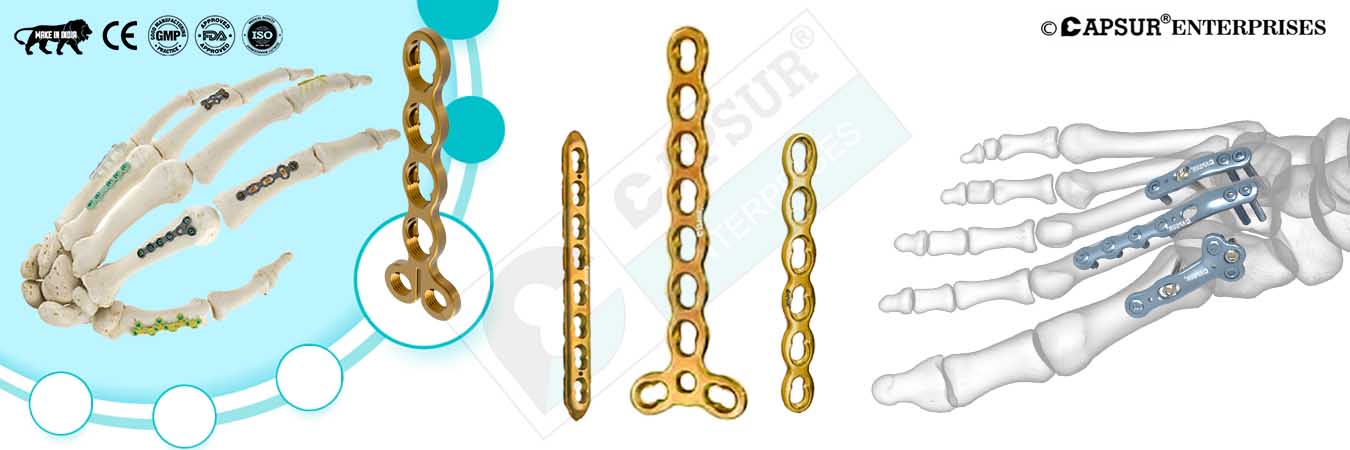
HAND AND FOOT IMPLANTS
Hand and Foot Plates are used to fix broken bones in the hand, foot, or both. It is a small metal plate that is surgically put on the broken bone to hold it in place and help it heal. Most of the time, these plates are used when a broken bone is too big, moved, or unstable to be treated with a cast or splint alone.
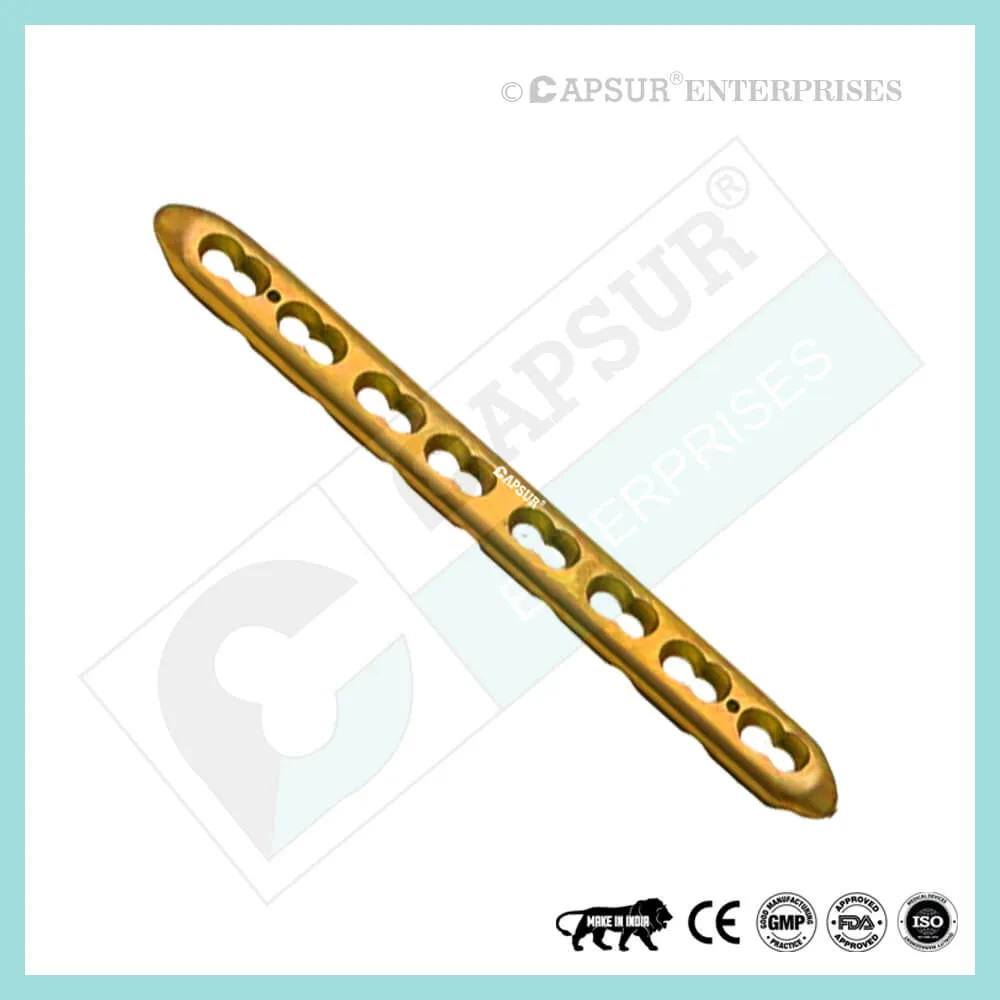
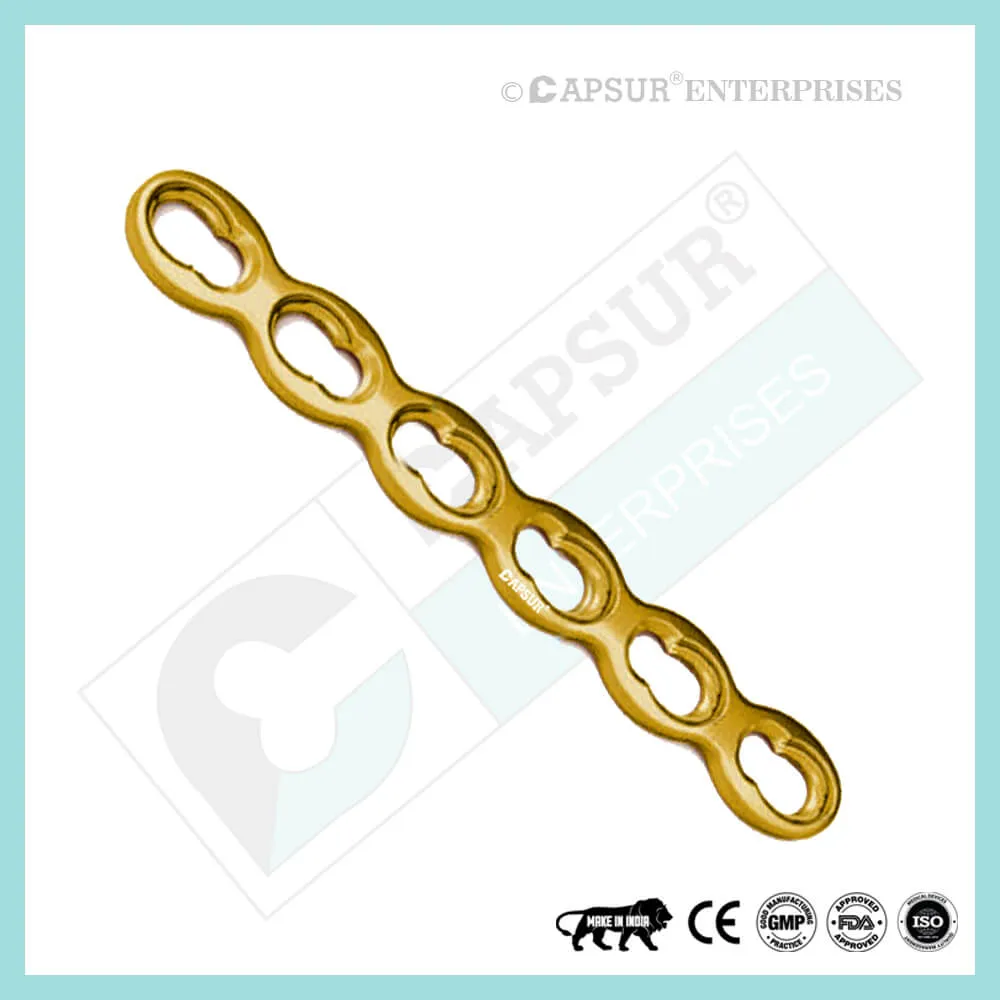
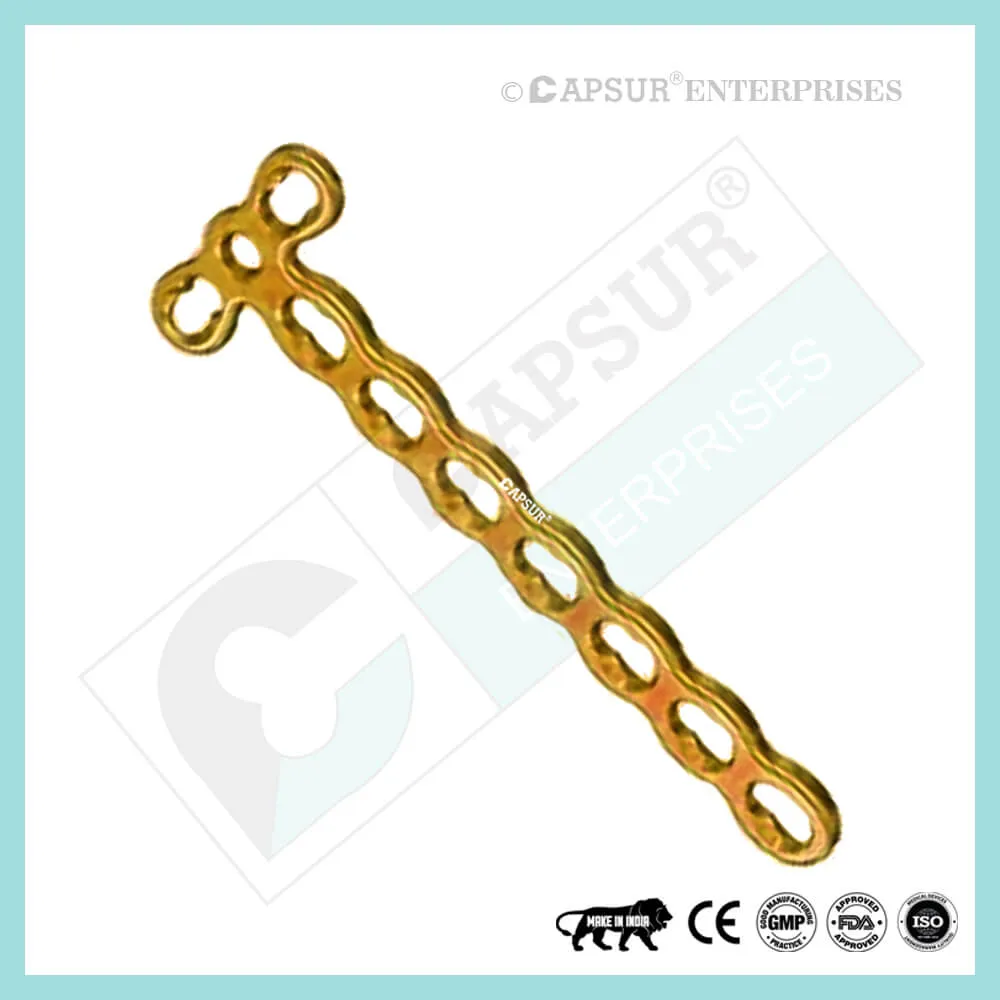
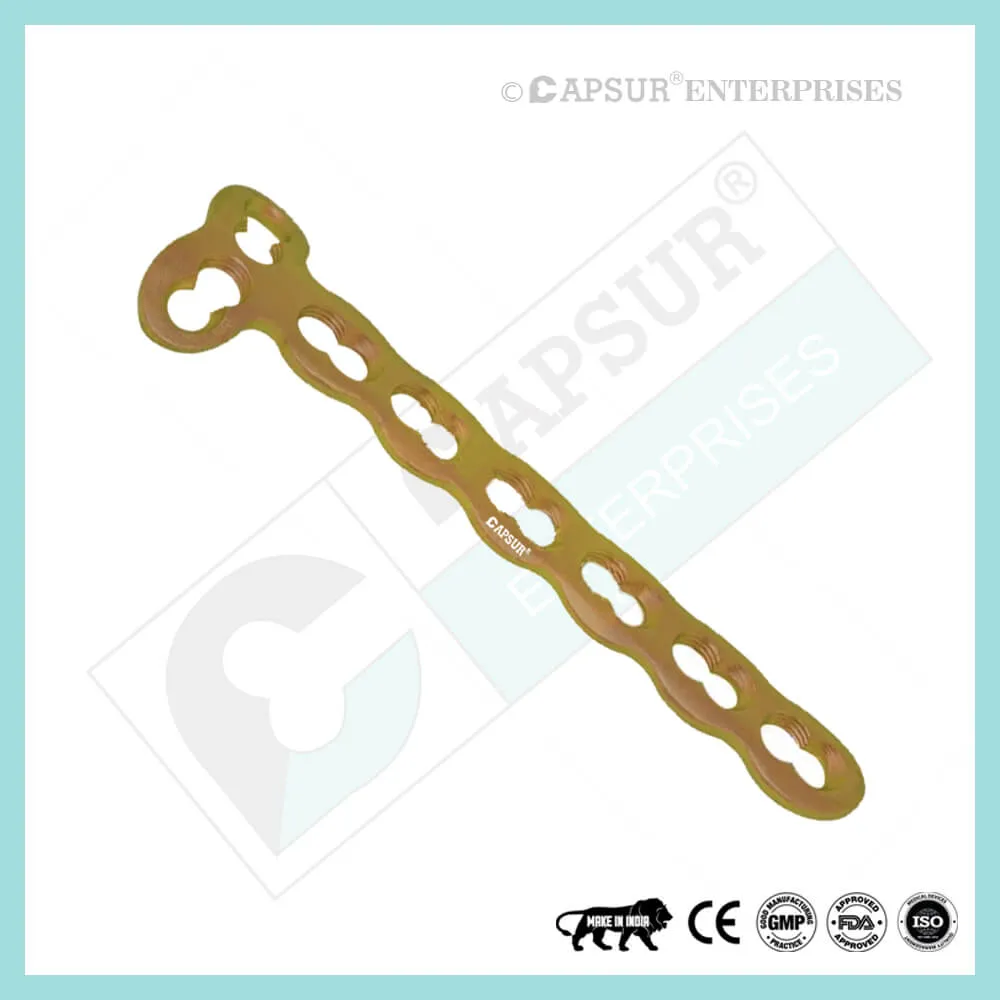
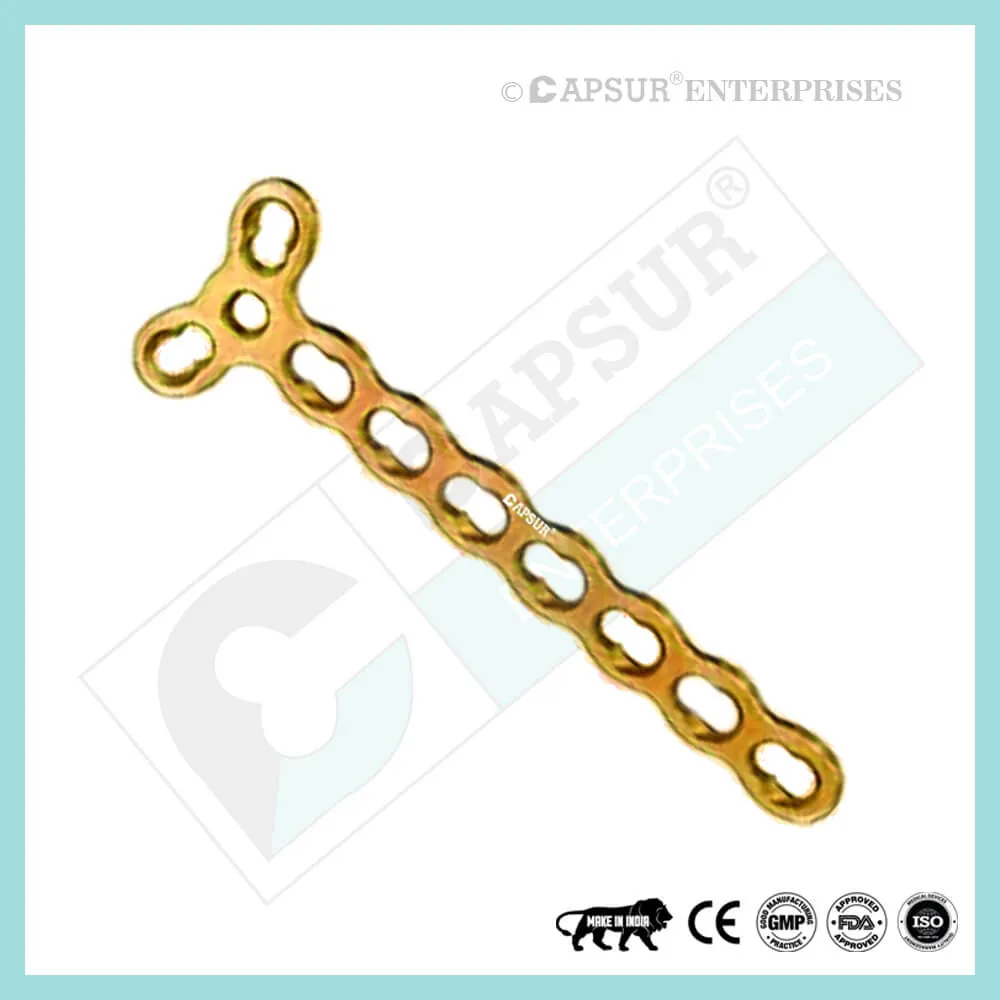
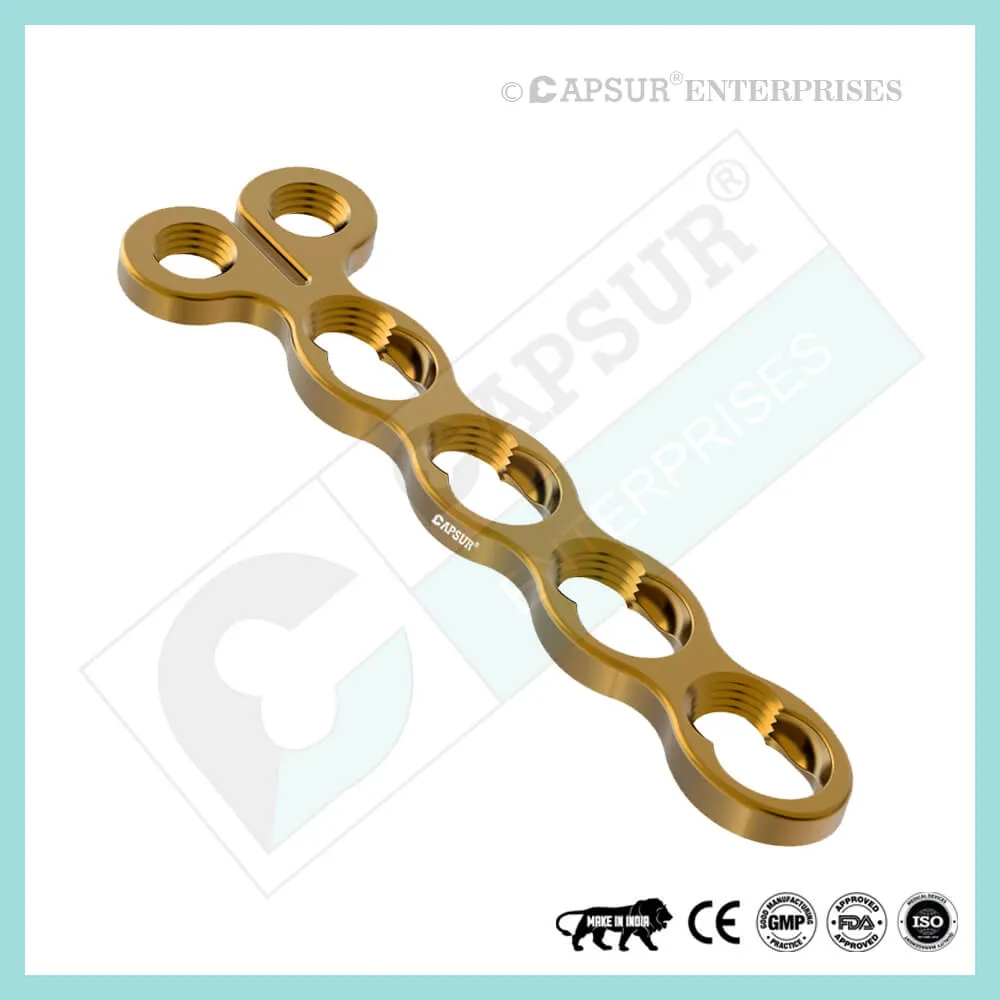
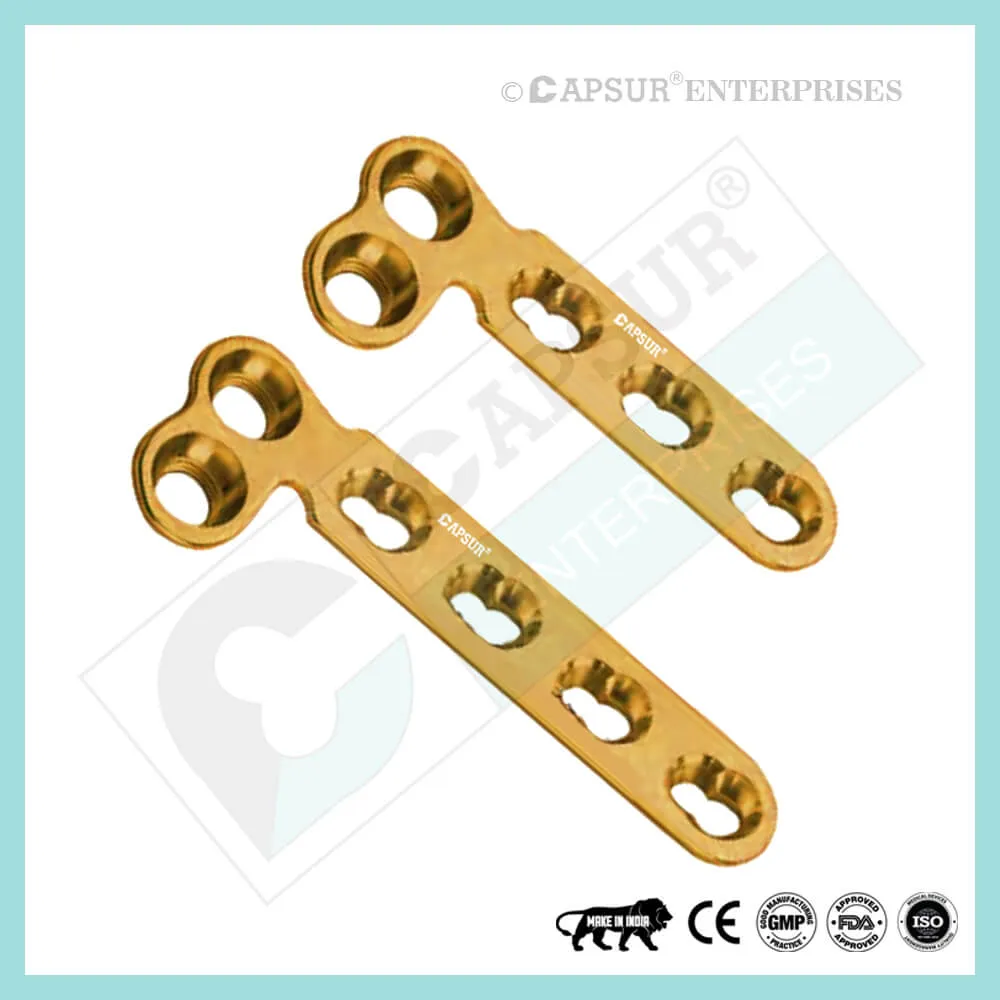
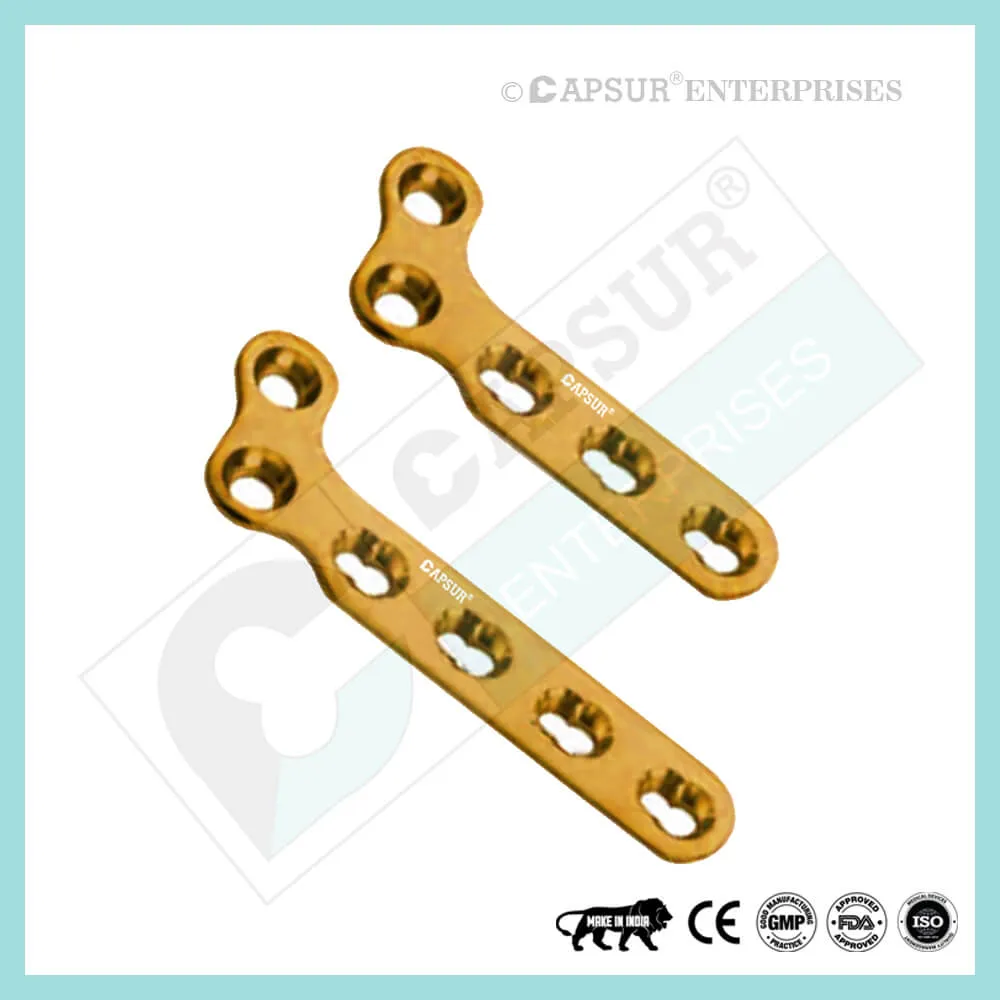
Categories
- Straight Plate With Gap (Titanium)
- Straight Plate With Continue Hole (Titanium)
- ‘T’ – Plate 02 Head Hole (Titanium)
- ‘T’ – Plate 03 Head Hole (Titanium)
- Chin Plate (Titanium)
- Square Plate (Titanium)
- Rectangular 3D – Plate (Titanium)
- ‘Y’ – Plate 02 Head Hole (Titanium)
- ‘Y’ – Double End Plate 02 Head Hole (Titanium)
- ‘L’ – Plate 02 Head Hole – 90° – L/R (Titanium)
- ‘L’ – Plate 03 Head Hole – 90° – L/R (Titanium)
- ‘L’ – Oblique Angle Plate 02 Head Hole – 120° – L/R (Titanium)
- ‘L’ – Oblique Angle Plate 03 Head Hole – 120° – L/R (Titanium)
- ‘X’ – Plate (Titanium)
- Orbital Plate Without Gap (Titanium)
- Orbital Plate With Gap (Titanium)
- Mesh Plate (Titanium)
- ‘I’ Plate (Titanium)
- ‘H’ Plate (Titanium)
- ‘Z’ Plate (Titanium)
- Delta Plate (Titanium)
- ‘T’ Oblique Angle Plate 03 Head Hole – L/R (Titanium)
- Maxillofacial Screw (Self tapping) – Head Cross Slot (Titanium)
- Angle Reconstruction Plate Mandible
- Double Angle Reconstruction Plate Mandible
- MAXILLOFACIAL INSTRUMENT SET
- 2/2.4/2.7 mm Locking Compression Plate
- 2/2.4/2.7 mm Locking Adaption Plate
- 2/2.4/2.7 mm Locking T Adaption Plate 3 Head Holes
- 2/2.4/2.7 mm Locking T Adaption Plate 2 Head Holes
- 2/2.4/2.7 mm Locking Y Adaption Plate
- 2/2.4/2.7 mm Locking Condylar Plate
- 2/2.4/2.7 mm Locking L Plate
- 2/2.4/2.7 mm Locking L Plate Angle
- 2.7 mm Variable Angle Locking Two Column Volar Distal Radius Plate
- 2.7 mm Locking Dorsal Distal Radius Straight Plate
- 2.7 mm Locking Volar Column Distal Radius Plate 9 Head Holes
- 2.7 mm Locking Volar Column Distal Radius Plate 8 Head Holes
- 2.7 mm Locking Dorsal Distal Radius T Plate 3 Head Holes
- 2.7 mm Locking Volar Long Distal Radius Plate 4 Head Holes
- 2.7 mm Locking Volar Extra-Articular Distal Radius Plate 4 Head Holes
- 2.7 mm Locking Volar Extra-Articular Distal Radius Plate 5 Head Holes
- 2.7 mm Locking Volar Juxta-Articular Distal Radius Plate 5 Head Holes
- 2.7 mm Locking Volar Distal Radius Buttress Plate 5 Head Holes
- 2.7 mm Locking Dorsal Distal Radius L Plate 2 Head Holes
- 2.7 mm Locking Dorsal Distal Radius L Plate 3 Head Holes
- 2.7 mm Locking Dorsal Distal Radius L Plate Oblique
- 2.7 mm Locking Proximal Radius Radial Head Rim Plate
- 2.7 mm Locking Proximal Radius Radial Head Neck Plate
- 2.7 mm Locking Compression Plate
- 2.7 mm Locking Reconstruction Plate Straight
- 2.7 mm Locking Reconstruction Plate Curved
- 2.7 mm Locking Reconstruction Plates Straight Low Profile
- 2.7 mm mm Locking Reconstruction Plates Curved Low Profile
- 2.7 mm Locking T Plate 2 Head Holes
- 2.7 mm Locking T Plate 3 Head Holes
- 2.7 mm Locking T Plate Angle 3 Head Holes
- 2.7 mm One Third Tubular Plate
- 2.7 mm Locking Pediatric Hip Plates
- 3-5 mm Locking Reconstruction Plate Curved
- 3-5 mm Locking Reconstruction Plate Straight Low Profile
- 3-5 mm Locking Reconstruction Plate Curved Low Profile
- 3-5 mm Locking T Plate 4 Head Holes
- 3-5 mm Locking Hook Plate
- 2-7-3-5 mm Locking Wrist Fusion Plate
- 2-7- 3-5 mm Locking Dorsolateral Distal Humerus Plates
- 2-7- 3-5 mm Locking Lateral Distal Fibula Plate
- 2-7- 3-5 mm Locking Medial Distal Humerus Plates
- 2-7- 3-5 mm Locking Superior Anterior Clavicle Plate Lateral Extension
- 2-7-3-5 mm Locking Dorsolateral Distal Humerus Plates With Support
- 3-5 mm Locking Anterolateral Distal Tibia Plate
- 3-5 mm Locking Calcaneal Plate
- 3-5 mm Locking Compression Plate Low Contact
- 3-5 mm Locking Extra-Articular Distal Humerus Plate
- 3-5 mm Locking Medial Distal Tibia Plate with Tab
- 3-5 mm Locking Medial Distal Tibia Plate without Tab
- 3-5 mm Locking Medial Proximal Tibia Plate
- 3-5 mm Locking Olecranon Plate
- 3-5 mm Locking One Third Tubular Plate
- 3-5 mm Locking Pediatric Hip Plate
- 3-5 mm Locking Pilon Plate
- 3-5 mm Locking Posteromedial Proximal Tibia Plate
- 3-5 mm Locking Proximal Tibia Plate
- 3-5 mm Locking Reconstruction Plate Straight
- 3-5 mm Locking Superior Anterior Clavicle Plate
- 3-5 mm Locking T Plate 3 Head Holes
- 3-5 mm Locking T Plate Angle 3 Head Holes
- 3-5 mm PHILOS Plate
- Eight Plate
- LCP Clavicular S- Plate
- LCP Humeral Distal Medial -3-5
- 33-5 mm Locking Clavicle Hook Plate
- LCP Olecranal type II
- LCP Proximal Humeral Long Philos
- LCP Proximal Humeral short – LPHP
- 4-5-5 mm Locking Broad Compression Plate Low Contact
- 4-5-5 mm Locking Distal Femoral Plate
- 4-5-5 mm Locking Medial Proximal Tibia Plate
- 4-5-5 mm Locking Narrow Compression Plate Low Contact
- 4-5-5 mm Locking Proximal Femoral Hook Plate
- 4-5-5 mm Locking Proximal Femoral Plate
- 4-5-5 mm Locking Proximal Lateral Tibia Plate
- 4-5-5 mm Locking Proximal Tibia Plate-2
- 4-5-5 mm Locking Proximal Tibia Plate
- 4-5-5 mm Locking Reconstruction Plate Curved
- 4-5-5 mm Locking Reconstruction Plate Straight
- 4-5-5 mm Locking T Buttress Plate
- 4-5-5 mm Locking T Plate
- 5 mm Locking Condylar Femoral Plates
- 5 mm Locking DHS Plate
- 5 mm Locking Paediatric Hip Plate
- 5 mm Locking Paediatric Hip Plate1
- LCP Distal Lateral Tibia
- LCP Proximal Femoral Type II
- Locking DCS Plate 95 Degre
- Locking Trochanter Stabilizing Plate for DHS
- 3-5MM CALCANEAL PLATE
- 3-5MM CLOVERLEAF PLATE
- 3-5MM CURVED RECONSTRUCTION PLATE DC HOLES
- 3-5MM DCP SMALL PLATE
- 3-5MM LC- DCP SMALL PLATE
- 3-5MM ONE THIRD TUBULAR PLATE WITH COLLAR
- 3-5MM ONE THIRD TUBULAR PLATE
- 3-5MM SMALL T- PLATE OBLIQUE ANGLE 3 HEAD HOLE
- 3-5MM SMALL T- PLATE RIGHT ANGLE 3 HEAD HOLE
- 3-5MM SMALL T- PLATE RIGHT ANGLE 4 HEAD HOLE
- 3-5MM STRAIGHT RECONSTRUCTION PLATE DC HOLES
- 3-5MM Y RECONSTRUCTION PLATE
- 4-5MM 95 DCS PLATE DC HOLES
- 4-5MM 95 DCS PLATE ROUND HOLES
- 4-5MM 120 DOUBLE ANGLE DCS PLATE DC HOLES
- 4-5MM 130 DHS PLATE LONG BARRELL DC HOLES
- 4-5MM 130 DHS PLATE LONG BARRELL ROUND HOLES
- 4-5MM 130 DHS PLATE SHORT BARRELL DC HOLES
- 4-5MM 130 DHS PLATE SHORT BARRELL ROUND HOLES
- 4-5MM 135 DHS PLATE LONG BARRELL DC HOLES
- 4-5MM 135 DHS PLATE LONG BARRELL ROUND HOLES
- 4-5MM 135 DHS PLATE SHORT BARRELL DC HOLES
- 4-5MM 135 DHS PLATE SHORT BARRELL ROUND HOLES
- 4-5MM CURVED RECONSTRUCTION PLATE DC HOLES
- 4-5MM DCP BROAD PLATE
- 4-5MM DCP COBRA HEAD PLATE
- 4-5MM DCP CONDYLAR BUTRRESS PLATE
- 4-5MM DCP LATERAL TIBIA HEAD BUTRRESS PLATE
- 4-5MM DCP NARROW PLATE
- 4-5MM HOOK PLATE
- 4-5MM L- BUTRRESS PLATE
- 4-5MM LC- DCP BROAD PLATE
- 4-5MM LC- DCP CONDYLAR BUTRRESS PLATE
- 4-5MM LC- DCP LATERAL TIBIA HEAD BUTRRESS PLATE
- 4-5MM LC- DCP NARROW PLATE
- 4-5MM LENGTHENING BROAD PLATE 10 HOLES
- 4-5MM LENGTHENING NARROW PLATE 8 HOLES
- 4-5MM PROXIMAL TIBIA PLATE
- 4-5MM SEMI TUBULAR PLATE
- 4-5MM SPOON PLATE
- 4-5MM STRAIGHT RECONSTRUCTION PLATE DC HOLES
- 4-5MM T- BUTRRESS PLATE
- 4-5MM T- PLATE
- 4-5MM Y RECONSTRUCTION PLATE
- Anterior Cervical Plate (ACLP)
- 3.5 mm Anterior Cervical Screw
- 4 mm Anterior Cervical Screw
- Monoaxial Pedicle Screws
- Monoaxial Reduction Screws
- Polyaxial Pedicle Screws
- Polyaxial Reduction Screws
- Crosslink Connector / Transverse Connector Type 1
- Crosslink Connector / Transverse Connector Type 2
- Laminar Hook
- Pedicle Hook
- Connecting Rod
- Cervical Cage | Anterior Cervical Interbody Fusion ( ACIF Cage)
- Lumbar Cage | Posterior Lumbar Interbody Fusion (PLIF Cage)
- TLIF Cage | Transforaminal Lumbar Interbody Fusion Cage
- Titanium Mesh Cage
- Steinmann Pins
- Steinmann Pins Positive Profile Thread
- Steinman Pin Centre Thread (Denham Pin)
- Drill Bits
- Schanz Screw (Schanz Pin)
- Schanz Screw (Schanz Pin) Self Tapping
- Schanz Screw (Schanz Pin) Tapered Thread
- Kirschner Wire Single Trocar
- Kirschner Wire Double Trocar
- Kirschner Wire Double Trocar Fully Threaded
- Suture Wire / Cerclage Wire
- Cerclage Wire – Loop
- Guide Wire for Tibia/Femur, Ball Tip, 2.5 x 900 mm
- Guide Wire for Tibia/Femur, Plain, 2.5 x 900 mm
- Gigli Saw Wire
- Guide Wire for 4 mm Cancellous Cannulated Screws, 1.2 x 230 mm
- Guide Wire for 6.5 mm Cancellous Cannulated Screws, 2 x 230 mm
- Guide Wire for PFN 2/2.5/3 x 400 mm
- Ilizarov Wire Bayonet Point
- Ilizarov Wire Tocar Point
- Ilizarov Olive Wire Bayonet Pointa
- Ilizarov Olive Wire Tocar Point
- Epiphyseal Staple
- Coventry Staple
- Locking Cortical Screws
- Cortical Screws
- Locking Cancellous Screws
- Cancellous Screws
- Locking Cannulated Screws
- Cannulated Screws
- Headless Compression Screws Partially Thread
- Headless Compression Screws Full Thread
- Interlocking Nail Screws
- Interference Screws
- Herbert Screws Cannulated
- Malleolar Screws
- DHS-DCS Screws
- Cross Head Screws
- Anchor Screws
- ANCHOR SUTURE SCREW
- SUTURE DISC
- ENDOBUTTON
- MULTI SPIKED WASHER FOR LIGAMENT
- SUTURE POST
- SPIKED LIGAMENT STAPLE
- HERBERT SCREW
- ACL. SCREW (ANTERIOR CRUCIATE LIGAMENT SCREW)
- ANCHOR SUTURE SCREW PRE LOADED
- ENDOBUTTON WITH LOOP
- ENDOBUTTON WITH ADJUSTABLE LOOP
- BIO A.C.L. SCREW – PLA (POLYLACTIC ACID)
- BIO A.C.L. SCREW – B-TCP (B-TRICALCIUM PHOSPHATE)
- AESCULAP CLAMP(2.5mm)
- AESCULAP CLAMP(8mm)
- DOUBLE PIN CLAMP
- UNIVERSAL JOINT FOR TWO ROD
- AESCULAP CLAMP(4.0mm)
- A.O. TYPE CLAMP(4.5mm)
- OPEN CLAMP
- A.O. TYPE CLAMP(2.5mm)
- AESCULAP CLAMP(4.5mm)
- A.O. TYPE CLAMP(11mm)
- METAPHYTICAL CLAMP
- A.O. TYPE CLAMP(3.5mm)
- BALL & SOKET CLAMP
- CONNECTING ROD(2.5mm)
- CONNECTING ROD(4.0mm)
- CONNECTING ROD(20mm)
- CONNECTING ROD(3.0mm)
- CONNECTING ROD(8.0mm)
- CONNECTING ROD(1mm)
- BALL & SOKET TPANNER
- DISTRACTOR UNIT
- T-HANDLE SPANNER
- ALPHA CLAMP (LINK JOINT)
- BETA CLAMP (LINK JOINT) Size: 8mm X 12mm
- SINGLE PIN DISTRACTOR (M4) (CT.EV)
- BETA CLAMP (LINK JOINT) Dia.: 10mm X 15mm
- DOUBLE PIN DISTRACTOR (M4) (C.T.EV)
- DOUBLE PIN DISTRACTOR (M6) (C.T.EV)
- STEAIGHT ROD – KNURLED
- BENT ROD- KNURLED (SMALL “L” ROD)
- BENT ROD- KNURLED (LARGE “L” ROD)
- BENT ROD- KNURLED (“Z” ROD)
- ALLEN KEY
- HALF RING
- 5/8 RING
- FULL RING
- ITALIAN FEMORAL ARCH
- THREADED ROD (Dia.: 6.0mm)
- ARCH
- TRLESCOPIC ROD
- HINGES
- SIMPLE WASHER
- CONNICAL WASHER
- CONNICAL COUPLE WASHER
- POST – MALE
- POST – FEMALE
- OBLIQUE SUPPORT
- CURVED PLATE
- CONNECTING PLATE
- TWISTED PLATE
- CONNECTING BOLT
- WIRE FIXATION BOLT(HEX HEAD) (SLOTTED)
- WIRE FIXATION BOLT(HEX HEAD) (CENTRIC)
- WIRE FIXATION BOLT(TWO PART HEAD) (SLOTTED)
- WIRE FIXATION BOLT(TWO PART HEAD) (CENTRIC)
- NUT
- MULTY PIN FIXATION BOLT
- SINGLE PIN FIXATION BOLT
- WRENCH OF CUBE
- NYLON NUT
- UNIVERSAL JOINT
- SQUARE NUT
- THREADED SOCKET
- OLIVE WIRE (BAYONET POINT)
- OLIVE WIRE (TROCAR POINT)
- TENSION K-WIRE (BAYONET POINT)
- TENSION K-WIRE (TROCAR POINT)
- WIRE TENSIONER (MANNUAL)
- WIRE TENSIONER (DYNAMETRIC)
- ORDINARY FIX SPANNER
- RING SPANNER
- T-HANDLE SPANNER
- STEINMAN PIN
- DENHAM PIN
- SCHANZ SCREW
- SCHANZ SCREW (16 & 32mm Thread Length: 6″)
- SCHANZ SCREW (16 & 32mm Thread Length: 8″)
- SCHANZ SCREW (SELF DRILLING Length: 6″)
- SCHANZ SCREW TAPPER THREAD(32mm & 52mm Thread Dia.: 6.0mm)
- SCHANZ SCREW(CANCELLOUS THREAD)
- SCHANZ SCREW (SELF DRILLING Length: 8″)
- SCHANZ SCREW TAPPER THREAD(32mm & 52mm Thread Length: 08″)
- HIP TRACTION SCREW(Length: 8″)
- HIP TRACTION SCREW(Length: 10″)
- GUIDE PIN
- GUIDE PIN (THREADED)
- GUIDE WIRE LONG(Length: 30″)
- GUIDE WIRE LONG(Length: 40″)
- GUIDE WIRE LONG (OLIVE END)
- Screw Driver – Torque
- Screws Drivers – Fiber Handle
- Screws Drivers – Fiber Handle Cannulated
- Screws Drivers – Holding Sleeve
- Screws Drivers – Shaft Copuling
- Screws Drivers – T Handle
- Screws Drivers – Holding Sleeve for Craniomaxillofacial Screws
- Screws Drivers – PolyAxial Screws
- Screws Drivers – MonoAxial Screws
- Screws Drivers – Shaft Quick Coupling, SS Handle
- Screws Drivers – Shaft Quick Coupling, Plastic Handle
- Condylar Bone holding Forceps Ball Tip Ratchet Lock
- Condylar Bone holding Forceps Ball Tip Speed Lock
- Kern/Lane Bone Holding Forceps
- Self Centering Bone Holding Forceps Richat Lock
- Self Centering Bone Holding Forceps Speed Lock
- Hey Grooves Bone Holding Forceps
- Bone Holding Forceps Patella 3 Prong
- Bone Holding Forceps Patella 4 Prong
- Lowman Bone Clamp
- Burns Bone Holding Forceps Richat Lock
- Burns Bone Holding Forceps Speed Lock
- Bone and Plate Holding Forceps for Mini Plates
- Bone and Plate Holding Forceps-Type
- Bone and Plate Holding Forceps-Type2
- Fergusson (Fibula) Bone holding Forceps
- Plate and Bone Holding Forcep with Sliding
- Hohmann Retractor
- Gelpi Retractor
- Mastoid Retractor Self Retaining
- Mastoid Retractor Self Retaining-Extended
- Round Retractor Self Retaining
- Volkman Retractor
- Langenbeck Retractor
- Langenbeck Retractor Extended
- Cobra Retractor
- Cat Paw Retractor
- Charnley Retractor With Blades
- Weight and Chain for Charnley Retractor
- Charnley Pin Retractor and T Handle
- Lamina Spreaders
- Nerve Root Retractor
- Czerny Retractor
- Murphy Lane Bone Skid
- Rib Retractor Set with Hinged Arms & Four Blades
- Cloward cervical retractor with 15 Blade
- Dura Retractor
- McDonald Retractor Double Ended
- Broken Screw Removal Hollow Mill Shaft and Handle
- Trephine T Handle
- Broken Screw Removal T Handle
- Broken Screw Head Removal Forceps Ratchet Lock
- Broken Screw Head Removal Forceps Speed Lock
- Broken Screw Removal Richat Lock
- Broken Screw Removal Conical
- Screw Holding Forceps
- Broken Nail Removal T Handle Set of 4 pieces
- Drill & ‘l’ap Sleeve Combirn’ld / Double Drill Guide/ Unive1•sa1 Drill Guide
- Double Drill Guide with Stopper and 2 Sleeve
- Drill Guide Neutral and Load
- Threaded Drill Guide
- Insert Drill Sleeve
- Drill Bit Sleeve
- Tap Sleeve
- Protection Sleeve, Dia 4.5 mm
- Triple Drill Guide
- Triple Trocar
- Pointed Drill Guide with 4.5 mm Tap Sleeve & 3.2 mm Insert Drill Sleeve
Hand and Foot Plates Introduction
Hand and Foot Plates are used to fix broken bones in the hand, foot, or both. It is a small metal plate that is surgically put on the broken bone to hold it in place and help it heal. Most of the time, these plates are used when a broken bone is too big, moved, or unstable to be treated with a cast or splint alone.
Usually, the plate is made of titanium and is made to have a low profile and fit the shape of the bone. Screws, which are also made of titanium and come in different sizes and lengths to fit different bone sizes and types of fractures, hold it to the bone.
Hand and Foot Plates are usually put on the underside of the bone so they don’t get in the way of the tendons and ligaments that run over the top of the hand. Most of the time, the plate stays in place for a few months to let the bone heal. After that, it can be taken out surgically.
It has been shown that these plates improve the outcome of treatment for hand and foot fractures by a lot. They shorten the time it takes to heal and lower the risk of problems like malunion or non-union, which means the bone doesn’t heal properly or doesn’t heal at all. But, like any surgery, using fracture plates on the hand comes with risks, such as infection, nerve damage, and the implant not working. Your doctor will look at your unique situation to decide if this is the best way to treat you.
Fractures of the hand and foot are common injuries that can happen to people of all ages. In some cases, surgery may be needed to fix the break and help the body heal properly. The type of Hand and Foot Plate used will depend on a number of things, such as the location and severity of the break, as well as the patient’s age and overall health. In some cases, a plate is used temporarily and then taken off once the bone has healed. In other cases, the plate stays in place for the rest of the patient’s life.
Specification Regarding Hand and Foot Plates
- Plates available holes are 3 to 10 holes depends on plate design.
- Plates are available in Titanium.
- The plate has both combination and round holes. Combi holes permit fixation with locking screws in the threaded section and compression screws in the section of the dynamic compression unit.
- The shaft holes accept 2/2.4/2.7 mm locking screws or cortical screws in the threaded and compression portions, respectively. Plate heads can accommodate 2/2.4/2.7 mm locking screws in the threaded portion and 2/2.4/2.7 mm cortical screws in the compression portion.
- Locking screws provide a fixed-angle construct to support the articular surface, reduce the requirement for bone grafting, and achieve fixation in osteoporotic bone.
- Hand and Foot Plates allow implant placement to address the fracture pattern of each individual patient.
- The limited-contact surface reduces bone-to-plate contact and protects the periosteal blood supply.
- Different plate length options eliminate the need to cut plates.
- Polished surface and rounded edges reduce tendon adhesion potential.
- The low profile of the plate and screw reduces the risk of tendon and soft tissue irritation.
- Individual fracture fragments are addressed by smaller plates and screws, with less overall implant bulk.
- The locking plate increases the structure’s stability and reduces the risk of screw back-out and subsequent reduction loss. Additionally, it reduces the need for precise anatomic plate contouring and reduces the possibility of stripped screw holes.
- For Hand and Foot Plates, a complete Instruments Set is offered. General instruments, such as a Plate Bending Press, Plate Holding Forceps, Plate Bending Pliers, Bone Holding Forceps, Bone Elevators, Bone Cutter, Bone Nibbler, Depth Gauge, Sleeve, Screw Driver, Trocar Sleeve, etc., are available for this plate.
Instruments for Hand and Foot Plates
Mini Fragment Instruments Set
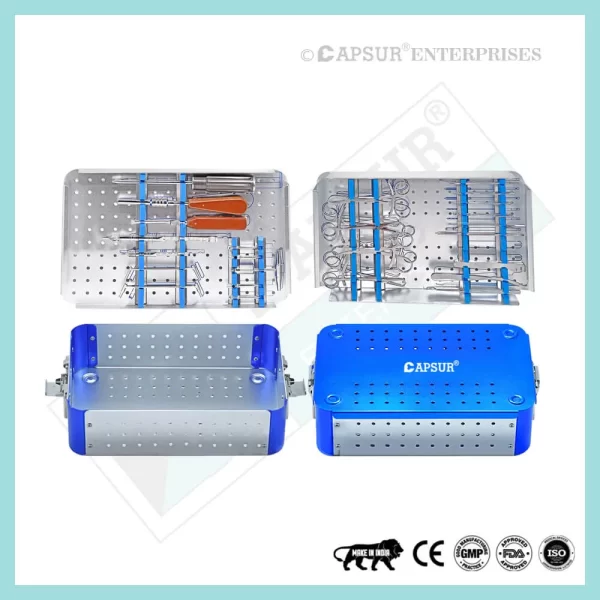
Benefits
Locking plates for Hand and Foot Plates have many benefits.
Locking plates for the hands and feet ensure secure attachment and eliminate the need for complete bone-to-plate contact. Stabilising the segments without drawing the bone to the plate, screws “lock” into the threaded screw holes of the plate upon tightening. Screw insertion cannot change the reduction because of the locking screws. When using a nonlocking plate and screw system, the plate must be precisely shaped to fit the patient’s bone. If the bone segments aren’t touching when the screws are tightened, the reduction and maybe even the occlusal relationship will be lost.
Instead of compressing the plate to the cortical bone, as is done with traditional plates, locking plate/screw systems allow for more blood flow to the injured area.
The plate is not likely to become unscrewed. A locking head screw will also prevent the bone graft from becoming dislodged while it is being incorporated into the plate and healing. This feature of a locking plate/screw system may be beneficial because it reduces the possibility of inflammatory complications brought on by hardware loosening.
In studies, locking plate/screw systems outperformed more common nonlocking plate/screw systems in terms of fixation stability.
Secure Fastening System
The threading on the plates is female and the threading on the heads of the locking screws is male. As a result, the screw’s head can be threaded into the hole in the Hand and Foot Plates. Thanks to this technological advancement, a fixed-angle structure can be built using standard plating procedures.
Technology for Locking Plates
A bone plate can be made into a fixed-angle construct by using locking screws. Secure bone purchase with conventional screws may be compromised in osteopenic bone or fractures with multiple fragments. Locking screws are similar to multiple small angled blade plates in that they both resist patient load but do not rely on bone/plate compression. Locking screws into a fixed-angle construct is especially important in cases of osteopenic bone or comminuted fractures.
The plate serves dual purposes as a locking device and a fracture compression device thanks to its combination of locking screw holes and compression screw slots in the shaft. Insert the standard screws into the compression screw slots before inserting any locking screws to achieve compression.

